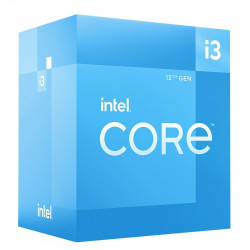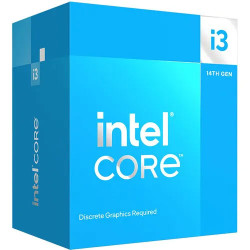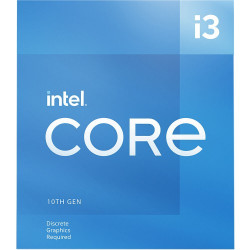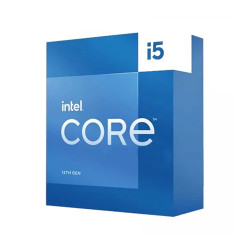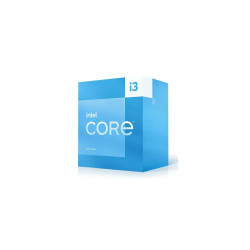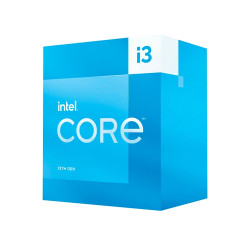Intel Processor
[ninja_tables id="47809"]
[ninja_tables id="48517"]
[ninja_tables id="47993"]
Intel’s Alder Lake processors are based on a new hybrid architecture that utilizes high-performance and high-efficiency cores. They claim it will have its best performance per watt yet. It’s 19% higher than the previous generation at the same clock speed, so they must be telling the truth! These chips will support DDR5 RAM and PCIe 5 which should make them perfect partners for your gaming PC in the future. You’ll also be pleased to know that they support your existing DDR4 RAMand PCle SSDs too!
If you want to get ahead of the curve with next-gen technology, then these processors are for you!
Intel’s highest performing CPUs for laptop and desktop PCs here in the Intel Core Series. From the top-end Intel Core i9 processors to our value-packed Intel Core i3 processors, business and creative professionals, gamers of all levels, and others can find an Intel Core processor that lets them do more.
Intel now has 12th-gen desktop processors from 16 cores down to only two, offering options across the price and performance spectrum. Although Alder Lake is known for having hybrid architecture, only about half of the chips come with a mix of performant (P) cores and efficient (E) cores. Here’s a look at the desktop range:
The balance of P-cores and E-cores is different for each intel processor model. Only the P-cores support hyperthreading, so the i9 model comes with 16 cores and 24 threads, the i7 model comes with 12 cores and 20 threads, and so on. Chips without the hybrid architecture come exclusively with P-cores, which support hyperthreading.
Frequency-wise, it’s hard to lock Alder Lake down. The P-cores and E-cores run at different frequencies, so there isn’t a single number to reference. With Intel’s updated Extreme Overclocking Utility (XTU), you can tweak the P-cores and E-cores independently to dial in an overclock.
The non-K models aren’t unlocked for overclocking, though some users have managed to bypass protective measures to overclock them anyway. Although Intel says not to overclock non-K models, it can result in as much as a 33% increase in performance for midrange processors.
[ninja_tables id="48517"]
[ninja_tables id="47993"]
Are you a gamer? Are you looking for a new computer? Are you looking for a new processor?
Intel’s Alder Lake processors are based on a new hybrid architecture that utilizes high-performance and high-efficiency cores. They claim it will have its best performance per watt yet. It’s 19% higher than the previous generation at the same clock speed, so they must be telling the truth! These chips will support DDR5 RAM and PCIe 5 which should make them perfect partners for your gaming PC in the future. You’ll also be pleased to know that they support your existing DDR4 RAMand PCle SSDs too!
If you want to get ahead of the curve with next-gen technology, then these processors are for you!
Intel Core Processor Family
Intel’s highest performing CPUs for laptop and desktop PCs here in the Intel Core Series. From the top-end Intel Core i9 processors to our value-packed Intel Core i3 processors, business and creative professionals, gamers of all levels, and others can find an Intel Core processor that lets them do more.
| Intel Core X-series Processors | Unlocked CPUs that deliver up to 18 cores for the most extreme gaming, creative production, and multi-tasking. |
| Intel Core i9 Processors | Delivering up to 16 unlocked cores for seamless 4K Ultra HD and 360 video, robust gameplay, and multitasking performance. |
| Intel Core i7 Processors | This CPU packs the power of up to 14 cores for accelerated computing supporting high-end gaming, connectivity, and security. |
| Intel Core i5 Processors | Experience exceptional performance for home and business PCs, with up to 12 cores for gaming, creativity and multitasking. |
| Intel Core i3 Processors | These value-packed processors deliver outstanding performance for everyday tasks. |
Intel Processor Specs
Intel now has 12th-gen desktop processors from 16 cores down to only two, offering options across the price and performance spectrum. Although Alder Lake is known for having hybrid architecture, only about half of the chips come with a mix of performant (P) cores and efficient (E) cores. Here’s a look at the desktop range:
| Processor Model | Cores | Base frequency | Max boost frequency | Intel Smart Cache (L3) | Integrated graphics | Base power | Max turbo power |
| Core i9-12900KS | 16 (8P + 8E) | 3.4GHz | 5.3GHz | 30MB | Intel UHD 770 | 150W | 241W |
| Core i9-12900K | 16 (8P + 8E) | 3.2GHz | 5.2GHz | 30MB | Intel UHD 770 | 125W | 241W |
| Core i9-12900KF | 16 (8P + 8E) | 3.2GHz | 5.2GHz | 30MB | N/A | 125W | 241W |
| Core i9-12900 | 16 (8P + 8E) | 2.4GHz | 5.1GHz | 30MB | UHD 770 | 65W | 202W |
| Core i9-12900F | 16 (8P + 8E) | 2.4GHz | 5.1GHz | 30MB | N/A | 65W | 202W |
| Core i7-12700K | 12 (8P + 4E) | 3.6GHz | 5.0GHz | 25MB | Intel UHD 770 | 125W | 190W |
| Core i7-12700KF | 12 (8P + 4E) | 3.6GHz | 5.0GHz | 25MB | N/A | 125W | 190W |
| Core i7-12700 | 12 (8P + 4E) | 2.1GHz | 4.9GHz | 25MB | UHD 770 | 65W | 180W |
| Core i7-12700F | 12 (8P + 4E) | 2.1GHz | 4.9GHz | 25MB | N/A | 65W | 180W |
| Core i5-12600K | 10 (6P + 4E) | 3.7GHz | 4.9GHz | 20MB | Intel UHD 770 | 125W | 150W |
| Core i5-12600KF | 10 (6P + 4E) | 3.7GHz | 4.9GHz | 20MB | N/A | 125W | 150W |
| Core i5-12600 | 6 | 3.3GHz | 4.8GHz | 18MB | UHD 770 | 65W | 117W |
| Core i5-12500 | 6 | 3.0GHz | 4.6GHz | 18MB | UHD 770 | 65W | 117W |
| Core i5-12400 | 6 | 2.5GHz | 4.4GHz | 18MB | UHD 730 | 65W | 117W |
| Core i5-12400F | 6 | 2.5GHz | 4.4GHz | 18MB | N/A | 65W | 117W |
| Core i3-12300 | 4 | 3.5GHz | 4.4GHz | 12MB | UHD 730 | 60W | 89W |
| Core i3-12100 | 4 | 3.3GHz | 4.3GHz | 12MB | UHD 730 | 60W | 89W |
| Core i3-12100F | 4 | 3.3GHz | 4.3GHz | 12MB | N/A | 58W | 89W |
| Pentium Gold G7400 | 2 | 3.7GHz | N/A | 6MB | UHD 710 | 46W | N/A |
| Celeron G6900 | 2 | 3.4GHz | N/A | 4MB | UHD 710 | 46W | N/A |
| Core i9-12900T | 16 (8P + 8E) | 1.4GHz | 4.9GHz | 30MB | UHD 770 | 35W | 106W |
| Core i7-12700T | 12 (8P + 4E) | 1.4GHz | 4.7GHz | 25MB | UHD 770 | 35W | 99W |
| Core i5-12600T | 6 | 2.1GHz | 4.6GHz | 18MB | UHD 770 | 35W | 74W |
| Core i5-12500T | 6 | 2.0GHz | 4.4GHz | 18MB | UHD 770 | 35W | 74W |
| Core i5-12400T | 6 | 1.8GHz | 4.2GHz | 18MB | UHD 730 | 35W | 74W |
| Core i3-12300T | 4 | 2.3GHz | 4.2GHz | 12MB | UHD 730 | 35W | 69W |
| Core i3-12100T | 4 | 2.2GHz | 4.1GHz | 12MB | UHD 730 | 35W | 69W |
| Pentium Gold G7400T | 2 | 3.1GHz | N/A | 6MB | UHD 710 | 35W | N/A |
| Celeron G6900T | 2 | 2.8GHz | N/A | 4MB | UHD 710 | 35W | N/A |
The balance of P-cores and E-cores is different for each intel processor model. Only the P-cores support hyperthreading, so the i9 model comes with 16 cores and 24 threads, the i7 model comes with 12 cores and 20 threads, and so on. Chips without the hybrid architecture come exclusively with P-cores, which support hyperthreading.
Frequency-wise, it’s hard to lock Alder Lake down. The P-cores and E-cores run at different frequencies, so there isn’t a single number to reference. With Intel’s updated Extreme Overclocking Utility (XTU), you can tweak the P-cores and E-cores independently to dial in an overclock.
The non-K models aren’t unlocked for overclocking, though some users have managed to bypass protective measures to overclock them anyway. Although Intel says not to overclock non-K models, it can result in as much as a 33% increase in performance for midrange processors.
Intel Processor
- Model: Core Ultra 9 285K
- Clock Speed: 3.2GHz up to 5.7GHz
- Cache: 36 MB, Socket: LGA1851
- CPU Cores: 24, CPU Threads: 24
- NPU: Intel AI Boost
75,500৳ 83,000৳
Ex Tax:75,500৳
- Model: Core Ultra 7 265K
- Clock Speed: 3.3GHz up to 5.5GHz
- Cache: 30 MB, Socket: LGA1851
- CPU Cores: 20, CPU Threads: 20
- NPU: Intel AI Boost
52,800৳ 58,000৳
Ex Tax:52,800৳
- Model: Core Ultra 5 245K
- Clock Speed: 3.6 GHz up to 5.2GHz
- Cache: 24 MB, Socket: LGA1851
- CPU Cores: 14, CPU Threads: 14
- NPU: Intel AI Boost
40,500৳ 44,550৳
Ex Tax:40,500৳
- Model: Core i9 14900KF
- Clock Speed: 3.20 GHz up to 6.00 GHz
- Cache: 36 MB Intel Smart Cache
- CPU Cores: 24, CPU Threads: 32
- Socket: LGA1700
66,500৳ 73,150৳
Ex Tax:66,500৳
- Model: Core i9 14900K
- Clock Speed: 3.20 GHz up to 6.00 GHz
- Cache: 36 MB Intel Smart Cache, Socket: LGA1700
- CPU Cores: 24, CPU Threads: 32
- Intel UHD Graphics 770
68,500৳ 75,680৳
Ex Tax:68,500৳
- Cache: 30 MB, Socket: LGA1700
- Clock Speed: 3.40 GHz up to 5.40 GHz
- Model: Core i7 13700K
- CPU Cores: 16, CPU Threads: 24
- Graphics: Intel UHD Graphics 770
45,900৳ 50,490৳
Ex Tax:45,900৳
- Model: Core i7 14700KF
- Clock Speed: 3.4 GHz up to 5.6 GHz
- Cache: 33 MB Intel Smart Cache
- CPU Cores: 20, CPU Threads: 28
- Socket: LGA1700
46,500৳ 51,150৳
Ex Tax:46,500৳
- Model: Core i5 14600K
- Clock Speed: 3.5 GHz up to 5.3 GHz
- Cache: 24 MB, Socket: LGA1700
- CPU Cores: 14, CPU Threads: 20
- Graphics: Intel UHD Graphics 770
36,500৳ 40,150৳
Ex Tax:36,500৳
- Model: Core i5 14400F
- Clock Speed: 3.5 GHz up to 4.7 GHz
- Cache: 20 MB Intel Smart Cache
- CPU Cores: 10, CPU Threads: 16
- Socket: LGA1700
24,700৳ 27,280৳
Ex Tax:24,700৳
- Model: Core i3-12100F 12th Gen
- Clock Speed: 3.30 GHz Up to 4.30 GHz
- Cache: 12MB, Socket: LGA 1700
- CPU Cores: 4, CPU Threads: 8
- Max Memory Size: 128 GB
11,200৳ 12,100৳
Ex Tax:11,200৳
- CPU Cores: 4, CPU Threads: 8
- Cache: 12MB, Socket: LGA 1700
- Clock Speed: 3.30 GHz Up to 4.30 GHz
- Model: Core i3-12100 12th Gen
- Graphic: Intel UHD Graphics 730
11,200৳ 12,320৳
Ex Tax:11,200৳
- Model: Core i3 14100
- Clock Speed: 3.5 GHz up to 4.7 GHz
- Cache: 12 MB, Socket: LGA1700
- CPU Cores: 4; CPU Threads: 8
- Intel UHD Graphics 730
18,300৳ 20,200৳
Ex Tax:18,300৳
- Speed 3.70 GHz up to 4.40 GHz
- Socket Supported FCLGA1200
- Model: Intel Core i3 10105
- Cores- 4 & Threads- 8, 6M Cache
- Intel UHD Graphics 630
11,900৳ 13,090৳
Ex Tax:11,900৳
- Model: Core i5 13600K
- Clock Speed: 3.50 GHz up to 5.10 GHz
- Cache: 24 MB, Socket: LGA1700
- CPU Cores: 14, CPU Threads: 20
- Graphics: Intel UHD Graphics 770
36,500৳ 39,500৳
Ex Tax:36,500৳
- CPU Cores: 14, CPU Threads: 20
- Cache: 24 MB, Socket: LGA1700
- Clock Speed: 2.50 GHz up to 4.80 GHz
- Model: Core i5 13500
- Graphics: Intel UHD Graphics 770
25,800৳ 28,380৳
Ex Tax:25,800৳
- Model: Core i5 13400
- Clock Speed: 2.50 GHz up to 4.60 GHz
- Cache: 20 MB, Socket: LGA1700
- CPU Cores: 10, CPU Threads: 16
- Graphics: Intel UHD Graphics 730
24,999৳ 27,200৳
Ex Tax:24,999৳
- Model: Core i3-13100F
- Clock Speed: 3.40 GHz up to 4.50 GHz
- Cores: 4, Threads: 8
- Cache: 12 MB
- Socket: LGA 1700
13,500৳ 14,600৳
Ex Tax:13,500৳
- Model: Core i3-13100
- Clock Speed: 3.40 GHz up to 4.50 GHz
- Cores: 4, Threads: 8
- Cache: 12 MB
- Socket: LGA 1700
16,000৳ 17,300৳
Ex Tax:16,000৳
- Model: Core i9-12900K
- Clock Speed: 3.70 GHz Up to 5.20 GHz
- Cache: 30 MB, Socket: LGA 1700
- CPU Cores: 16, CPU Threads: 24
- GPU name: Intel UHD Graphics 770
47,000৳ 51,700৳
Ex Tax:47,000৳
- Cores: 12, Threads: 20
- Clock Speed: 3.60 GHz Up to 5.0 GHz
- Model: Core i7-12700K
- Cache: 25 MB Intel Smart Cache
- Socket: LGA 1700
31,500৳ 34,650৳
Ex Tax:31,500৳










